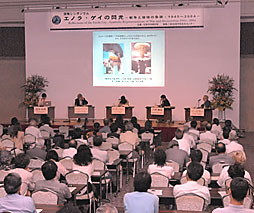
The B29 bomber Enola Gay that dropped the atomic bomb on Hiroshima is on public display in the National Air and Space Museum in the US. The international symposium "Reflections of the Enola Gay: Symbolic Representations of War and Destruction, 1945-2004" took place on July 31st at the International Conference Center, Hiroshima located in Naka-ku, Hiroshima City. The main sponsor, the Hiroshima Peace Institute of Hiroshima City University, presented five scholars from Japan and elsewhere to an audience of approximately two hundred.
Professor Lawrence Wittner of the State University of New York, US, criticized the display of the bomber saying it was "like displaying the poison gas the Germans used [to slaughter the Jews]." Professor Tony Coady of the University of Melbourne, Australia, declared, "The atomic bombing was a terrorist act using a weapon of mass destruction."
Professor Laura Hein of Northwestern University, US, while lamenting the fact that the display is not accompanied by a description of the A-bomb damage, expressed her expectation that this would continue to be debated within the US saying, "I think visitors feel the lack and will continue to raise the issue."
Professor Takashi Kawamoto in the graduate school at the University of Tokyo, Japan, asserted strongly that, "It is important to go over and over the common ground within the differences between the US and Japan." Then Professor Yuki Tanaka of the Hiroshima Peace Institute, Japan, said, "It is essential that aggressors study and share the memories of the victims." The Hiroshima Peace Memorial Museum (Naka-ku) is apparently a place for sharing such memories.
Various opinions were expressed by the audience as well, including, a hibakusha who insisted that "it is necessary to sue the United States in an international court for dropping the A-bomb," and a former American soldier and Japanese prisoner of war, who responded with, "The atomic bomb saved the lives of many American soldiers who were condemned to death."
(Caption)Symposium sharing historical understandings of the atomic bombing and the problem of the Enola Gay display
    
|